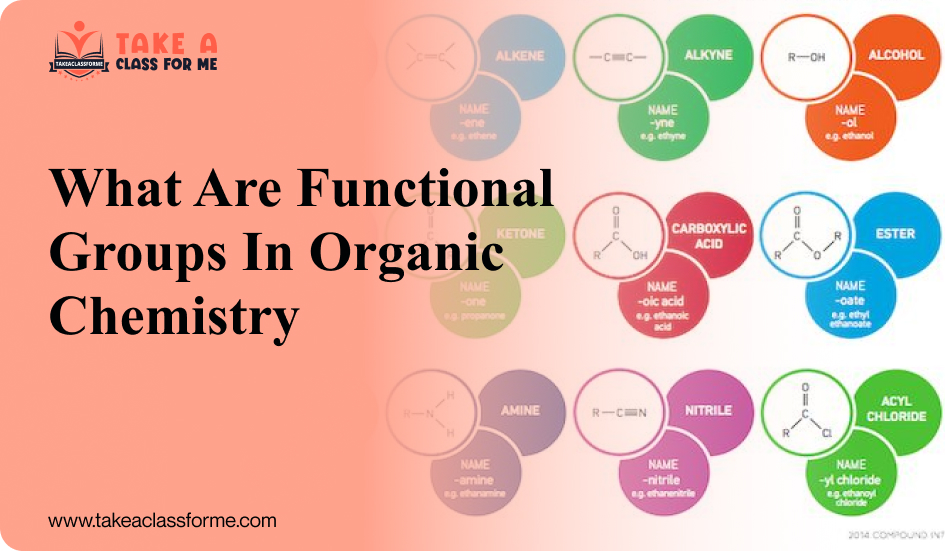
Carbon is one of the most versatile elements, and in organic chemistry, we will explore how carbon will do some serious molecular magic!
Brief Introduction to Organic Chemistry
Organic Chemistry is the branch of chemistry that is dedicated to studying carbon-based compounds. Most organic compounds contain the bonding of carbon and hydrogen, but they may also include many other elements. (e.g. oxygen, nitrogen, sulfur, phosphorus)
These compounds, also known as molecular compounds, explore the structure, properties, composition, reaction, and synthesis involved in their production. They play an important role in various fields, such as medicine, biology, and environmental studies.
The Chemistry of carbon compounds pervades every aspect of our lives. We use thousands of carbon compounds every day. They are carrying out important reactions within our bodies.
Functional Groups
A functional group is a specific arrangement of atoms that are connected to a molecule in a specific way. These functional groups are responsible for chemical properties and reactions in organic compounds.
Functional groups also play an important part in organic compound nomenclature; combining the names of the functional groups with the names of the parent alkanes provides a way to distinguish compounds.
Some common functional groups include hydroxyl (-OH), carboxyl (-COOH), amino (-NH₂), and carbonyl (C=O).
How Functional Groups Determine Chemical Properties
Functional groups are crucial in understanding the chemical behavior of the molecules. No matter how large a molecule is, the same functional group will typically undergo the same or similar chemical reactions. This is because the atoms of the functional groups are linked together in a certain way, creating a predictable behavior. Therefore, functional groups become vital for chemists, as they help to predict how different compounds will behave depending on the functional groups present within them, leading to a better understanding of organic chemistry.
Functional groups also influence a molecule’s reactivity; for example, a carboxyl group (-COOH) can make a molecule acidic by donating protons (H+), while an amino group can make it basic by accepting protons. Additionally, functional groups also determine if a compound acts as an acid or a base, which is crucial for biological processes in our bodies.
In addition to influencing the chemical behavior of the molecules, they also affect the physical properties such as the boiling and melting points. For example, molecules with large functional groups will exhibit a higher boiling point because a substantial amount of energy will be required to break the stronger intermolecular forces.
Why Are Functional Groups Important?
Importance of Functional Groups in Organic Chemistry
In organic chemistry, functional groups are key players in understanding how molecules behave. They are a specific group of atoms, bonded in a particular arrangement within a molecule that gives a compound certain physical and chemical properties.
Functional groups are essential in organic chemistry as they are useful in classifying compounds based on their chemical reactions. These functional groups form the backbone of organic chemistry, helping us classify and understand the countless reactions these molecules undergo!
They are also crucial in organic chemistry as they determine the properties and reactivity of organic molecules. They influence how molecules will react in the chemical processes, affect their polarity and solubility in water, and decide whether they will act as an acid or a base. Understanding functional groups helps predict how different substances will interact is fundamental to the study of organic chemistry.
Types of Functional Groups
Here are the main types of functional groups that are encountered in organic chemistry:
Hydroxyl Group (-OH)
- Properties: A hydroxyl group consists of a hydrogen atom bonded to an oxygen atom. They play a key role in the structure of many molecules. For example, water and alcohol both share some similar properties as they both contain hydroxyl groups.
In water, both alcohol and water molecules can form stronger hydrogen bonds with each other. Hence, alcohols forming these hydrogen bonds, tend to be soluble in water. So, we say the hydroxyl group is ‘water-loving’ or hydrophilic.
- Examples: Alcohols, such as ethanol and methanol are common examples.
Carbonyl Group (C=O)
- Explanation: A carbonyl is a functional group in organic chemistry in which a carbon atom is double-bonded with an oxygen atom.
- Examples: Ketones and aldehydes.
Both aldehydes and ketones contain the carbonyl group (C=O)
An aldehyde has at least one hydrogen atom or two hydrogen atoms attached to the carbonyl carbon atom. The general formula of an aldehyde is R-CHO.
A ketone has two hydrocarbon groups (alkyl) bonded to the carbonyl carbon atom. Their chemical formulae can be generalized to R-(C=O)-R’.
Carboxyl Group (-COOH)
- Characteristics: A carboxyl group is a combination of both carbonyl and hydroxyl groups. The chief characteristic of carboxy groups or carboxylic acids is their acidity. They are generally more acidic than other organic compounds.
- Applications: Carboxylic acids are widely used, and they include amino acids and acetic acids. Carboxylic groups, such as acetic acid (found in vinegar), are used as preservatives and to enhance flavors in food products. The production of soft drinks and many other food products involves the use of many carboxylic acids.
Amino Group (-NH2)
- Importance in amino acids and proteins: The amino group is a functional group that consists of a single nitrogen bonded to two hydrogen atoms. Amino acids are the building blocks of protein. They are very essential in performing many biological and chemical processes within the human body and are necessary ingredients in the growth and development of the human beings.
Alkyl Groups (R-)
An alkyl group is formed by removing one hydrogen atom from the alkane chain. They are characterized by their hydrophobic nature and are insoluble in water.
- Examples: Common alkyl groups include methyl (-CH₃), ethyl (-C₂H₅), and propyl (-C₃H₇).
For example, removing a hydrogen from a methane (-CH4), generates a methyl group (-–CH3)
Other Key Groups:
- Sulfhydryl (-SH): The sulfhydryl group is a group containing sulfur attached to a hydrogen atom. The sulfur atom is not nearly as electronegative as oxygen, so the S-H bond is considerably less polarized.
This group is also known as a thiol group. The basic sulfhydryl formula is R-SH. These are important and found in the structure of proteins,
- Phosphate (-PO4): This group contains a phosphorus atom bonded to four oxygen atoms. Phosphate groups are special because the bond they create is relatively stable at high energies. They play a critical role in energy transfer in biological systems (e.g., ATP) and the structure of nucleic acids (DNA and RNA).
- Halide groups (e.g., -Cl, -Br): Haloalkanes, or alkyl halides, are the functional groups that contain a bond between a carbon atom and a halogen. The halogen atoms are fluoride, chloride, bromide, iodine, and astatine
Alkyl halides are used as cleansing agents and for creating cleaning formulas. They are also used as paint removers and refrigerants.
Functional Groups and Chemical Reactions
Functional groups play a central role in various types of reactions, e.g. substitution, addition, and elimination.
Substitution Reactions
In a substitution reaction, one function group in a molecule is replaced by another function group. These types of reactions typically occur in saturated compounds like alkanes and alcohols, where a stable atom or group is exchanged for another.
A common example is a reaction between alcohol and halogen. For example, when ethanol ( a hydroxyl group) reacts with hydrogen chloride, the (-OH) is replaced by a Chloride ion (-Cl):
Ethanol + HCl → Ethyl chloride + H2O
Addition Reactions
An addition reaction is a reaction in which one atom or molecule is added to an unsaturated molecule such as alkenes or alkynes that contain double or triple bonds.
For example, consider the example of ethene (C₂H₄) and bromine (Br₂). In this reaction, the double bonds of ethene are broken down, letting 2 bromine atoms attach across the double bonds, forming 1,2-dibromoethane:
Ethene + Br2 → 1,2-Dibromoethane
Elimination Reactions
Elimination reactions in organic chemistry, are a type of reaction in which two atoms or groups of molecules are removed, resulting in the formation of double or triple bonds. This process converts a saturated compound (one with a single bond only) into an unsaturated compound. (containing double or triple bonds)
Example of Elimination Reaction: A classic example of elimination reaction is the dehydration of ethanol, where a water molecule is removed from the ethanol
In this reaction, a hydroxyl group (-OH) and a hydrogen atom are eliminated from neighboring carbons, resulting in the formation of a double bond between the two carbon atoms
Ethanol → Ethene + H2O
Result: Water is removed, forming a double bond (alkene)
Common Examples of Functional Groups in Everyday Life
These functional groups can be located not just in textbooks but in every aspect of your everyday life. Let’s have a look at some of these examples:
Alcohols in Beverages
Ethanol, an alcohol that is found in beer and wine, is an alcohol with a hydroxyl group (-OH). This group makes ethanol soluble in water, which is why you can have water-based beverages with alcohol.
Esters in Fragrances
Have you ever noticed the sweet, fruity scents in perfumes, body sprays, essential oils, and scented candles? That is because of the presence of esters in them. Esters contain a carbonyl group (C=O) attached to an oxygen atom. They are the reason perfumes and other products give off such fragrant scents!
Real World Connection
The functional groups aren’t just made-up and superficial concepts, it is more than what you learn from classrooms and textbooks. You can find their presence in every product you use in your daily life. From your favorite drinks to the perfumes you wear regularly, these esters play a vital role in these products. Chemistry can be fascinating and make you feel relatable with the vast amount of things involved as you eat, drink, and enjoy them!
Want to PASS in your Chemistry Class?
Are you feeling overwhelmed with your online chemistry class? We understand that chemistry classes can become overwhelming and juggling life and studies can be hectic at times. That’s why we’re here to help!
If you’re worried about upcoming exams or just don’t have the time to keep up with assignments, you can count on us. Our service offers professional experts who can take your online chemistry class for you, handle your quizzes and exams, and help you succeed!
We will ensure your guaranteed success in chemistry class by taking the pressure off your shoulders so that you can focus on your priorities.
Conclusion
In conclusion, functional groups play an essential role in understanding how organic molecules behave and react, both in everyday life and in the world of chemistry. Whether it’s the hydroxyl group in alcohols or the carboxyl group in acids, these small structures make a big impact on everything from solubility to reactivity. By recognizing and studying these groups, you can predict how different compounds will interact in various conditions, which is crucial for applications in disciplines of medicine, environmental science, and materials development.
As you dive deeper into your chemistry studies, keep exploring the fascinating world of functional groups. You’ll find that they not only help you grasp complex concepts but also reveal connections to real-world phenomena. From the fragrances in your favorite perfumes to the medications that improve health, functional groups are the key players in organic chemistry. They play a crucial role in chemistry determining how various compounds behave and react.
Expert Assignment Writer
Hi everyone! Hello there, My name is Emily, and I provide Online Class Helper services in Los Angeles. Who says balancing between work or school by meeting and final tasks, and having a busy social life? I discovered “Take A Class For Me” when I couldn’t effectively manage the rigors of an online business management class. They were so helpful with our online class whether it be with tutorials or assignment submissions. I can now devote time and energy to a job, but I do not have to sacrifice academic performance for it.






